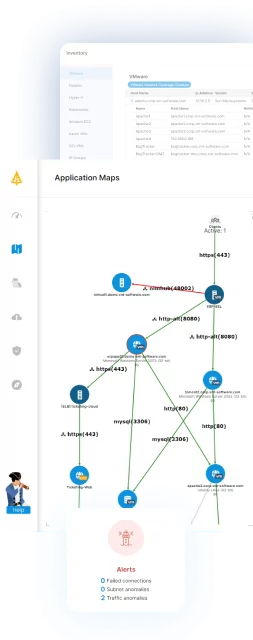What Is Network Security?
Network security involves protecting networks from unauthorized access, misuse, malfunction, modification, destruction, or improper disclosure. It ensures confidentiality, integrity, and availability (CIA) of network data and resources. This discipline includes technologies, processes, and policies to shield networks from internal and external threats.
Network security includes a range of tactics, from hardware solutions like firewalls to software for threat detection. It is crucial for maintaining business operations and protecting sensitive data from cybercriminals and other malicious actors. By implementing network security measures, organizations can mitigate risks and prevent data breaches and system disruptions.
Table of Contents
Toggle- What Is Network Security?
- Evolution of Network Security
- Common Threats to Network Security
- Tips from the Expert
- Network Security Architecture and Models
- Core Network Security Technologies and Tools
- 5 Best Practices for Effective Network Security
- Democratizing Network Security for Small IT Teams with Faddom
Evolution of Network Security
Network security has evolved significantly in response to the growing complexity of cyber threats. In the early days of computing, security was primarily physical—restricted access to mainframes and isolated networks. As organizations embraced networking and the internet, the need for digital security measures became evident.
The 1990s saw the rise of firewalls and antivirus software as the first line of defense. However, with the expansion of interconnected systems and eCommerce, attackers developed more sophisticated techniques. The 2000s introduced intrusion detection and prevention systems (IDS/IPS), virtual private networks (VPNs), and encryption protocols to improve security.
Today, network security integrates artificial intelligence (AI), machine learning, and zero-trust architectures to combat evolving threats. Cloud security, endpoint protection, and automated threat detection support modern defense strategies.
Common Threats to Network Security
There are several types of security threats that can affect an organization’s network.
Malware and Ransomware
Malware, short for malicious software, refers to a broad category of harmful programs, including viruses, worms, trojans, spyware, and ransomware. These programs infiltrate networks to steal data, disrupt operations, or provide attackers with remote access. Malware can spread through infected email attachments, malicious downloads, compromised websites, and software vulnerabilities.
Ransomware is one of the most damaging types of malware. It encrypts files or entire systems and demands payment in exchange for the decryption key. Some ransomware strains also exfiltrate data before encryption, threatening to leak sensitive information if the ransom is not paid. High-profile ransomware attacks have targeted organizations, healthcare institutions, and government agencies.
Phishing and Social Engineering
Phishing is a cyberattack technique where attackers impersonate trusted entities to trick individuals into revealing sensitive information, such as login credentials, banking details, or personal data. Phishing emails often contain malicious links or attachments that install malware or redirect victims to fraudulent websites designed to steal information.
Social engineering takes phishing a step further by exploiting human psychology. Attackers manipulate individuals into bypassing security protocols, often by creating a sense of urgency or trust. Common social engineering tactics include pretexting (fabricating a scenario to obtain information), baiting (offering fake incentives), and tailgating (physically following authorized personnel into restricted areas).
Denial-of-Service (DoS/DDoS) Attacks
A denial-of-service (DoS) attack aims to disrupt the availability of a network, server, or website by overwhelming it with excessive traffic or resource requests. A more severe variant, the distributed denial-of-service (DDoS) attack, involves multiple compromised devices—often part of a botnet—coordinating to flood a target system with malicious traffic, making it unavailable to legitimate users.
DDoS attacks can cripple online services, causing financial losses, reputational damage, and operational disruptions. Attackers use various techniques, such as volumetric attacks (flooding bandwidth), protocol attacks (exploiting weaknesses in network protocols), and application-layer attacks (targeting web applications).
Advanced Persistent Threats (APTs)
Advanced persistent threats (APTs) are prolonged, highly sophisticated cyberattacks where adversaries gain unauthorized access to a network and remain undetected for extended periods. These attacks are often carried out by state-sponsored groups or well-funded cybercriminal organizations, targeting government agencies, corporations, and infrastructure.
APTs typically involve multiple attack stages, including reconnaissance, initial compromise (e.g., through phishing or zero-day exploits), privilege escalation, data exfiltration, and persistence techniques to maintain long-term access. These attacks aim to steal intellectual property, disrupt operations, or gather intelligence over time.
Drive-By Downloads and Man-in-the-Middle Attacks
Drive-by downloads occur when users unintentionally download and install malicious software simply by visiting a compromised website. Attackers exploit vulnerabilities in web browsers, plugins, or outdated software to execute malware without user interaction. Drive-by downloads can lead to ransomware infections, spyware deployment, or system hijacking.
Man-in-the-middle (MitM) attacks involve intercepting and altering communications between two parties without their knowledge. Attackers position themselves between users and legitimate services to steal credentials, modify transactions, or inject malicious content. Common MitM techniques include Wi-Fi eavesdropping, session hijacking, and SSL stripping.
Insider Threats
Insider threats originate from individuals within an organization, such as employees, contractors, or business partners, who misuse their access to harm the organization. These threats can be intentional (malicious insiders seeking financial gain, revenge, or espionage) or unintentional (negligent insiders who accidentally expose data due to poor security practices).
Malicious insiders may steal sensitive data, introduce malware, or sabotage systems. In contrast, negligent insiders might fall victim to phishing scams, reuse weak passwords, or mishandle confidential information, increasing the risk of cyber incidents.

Lanir specializes in founding new tech companies for Enterprise Software: Assemble and nurture a great team, Early stage funding to growth late stage, One design partner to hundreds of enterprise customers, MVP to Enterprise grade product, Low level kernel engineering to AI/ML and BigData, One advisory board to a long list of shareholders and board members of the worlds largest VCs
Tips from the Expert
In my experience, here are tips that can help you better secure and optimize your network security implementation:
- Use decoy assets through deception technology: Deploy honeypots or decoy systems that mimic real network assets to detect intrusions early. Attackers who interact with these decoys trigger alerts, allowing security teams to respond before they reach critical systems.
- Implement network behavior anomaly detection (NBAD): While traditional detection relies on known signatures, NBAD focuses on identifying abnormal traffic patterns (e.g., data exfiltration attempts or lateral movement). It’s particularly effective against zero-day threats and insider attacks.
- Leverage software-defined perimeter (SDP) for dynamic segmentation: Instead of static network segmentation, consider SDPs, which dynamically create secure connections between users and resources based on real-time policy checks. This offers granular control while reducing attack surfaces.
- Integrate security orchestration, automation, and response (SOAR): Automate repetitive tasks, such as log correlation, threat containment, and alert management, using SOAR tools. This improves incident response times and allows security teams to focus on high-impact threats.
Network Security Architecture and Models
Defense in Depth
Defense in depth is a layered security approach to protect networks by implementing multiple defensive mechanisms. Instead of relying on a single security measure, this model ensures that if one layer fails, additional layers provide continued protection.
Key components of defense in depth include:
- Perimeter security: Firewalls, intrusion prevention systems (IPS), and access controls prevent unauthorized access.
- Endpoint protection: Antivirus software, endpoint detection and response (EDR), and patch management secure individual devices.
- Data security: Encryption, access control, and data loss prevention (DLP) protect sensitive information.
- User awareness: Security training and phishing simulations help prevent social engineering attacks.
- Monitoring and response: Security information and event management (SIEM) systems and threat intelligence enable rapid detection and mitigation of threats.
Zero Trust Architecture
Zero trust architecture (ZTA) is a security framework based on the principle of “never trust, always verify.” Unlike traditional security models that assume trust within the network perimeter, zero trust requires continuous authentication, authorization, and monitoring for every user and device accessing resources.
Core principles of zero trust include:
- Identity and access management (IAM): Multi-factor authentication (MFA) and least privilege access ensure that only authorized users can access resources.
- Microsegmentation: Network segmentation limits lateral movement, restricting access based on user roles and device posture.
- Continuous monitoring: AI-driven analytics and behavior-based threat detection help identify anomalies and potential threats.
- Encryption and secure access: Secure tunneling, such as virtual private networks (VPNs) and zero-trust network access (ZTNA), protects data in transit.
Network Segmentation
Network segmentation divides a network into smaller, isolated segments to control traffic flow and limit the spread of cyber threats. This strategy improves security, performance, and compliance by restricting unauthorized access to critical systems. It aids in preventing lateral movement by attackers and reducing the impact of breaches.
Types of network segmentation:
- Physical segmentation: Uses separate hardware, such as routers and switches, to isolate network segments.
- Logical segmentation: Implements virtual LANs (VLANs) and software-defined networking (SDN) to separate traffic within a shared infrastructure.
- Microsegmentation: Employs fine-grained policies to control access at the workload or application level, reducing attack vectors.
Visibility and Monitoring
Visibility and monitoring are critical for detecting and responding to cyber threats in real time. Organizations must maintain continuous oversight of network activity to identify suspicious behavior and mitigate risks.
Key components include:
- Security information and event management (SIEM): Centralized logging and correlation of security events help detect anomalies.
- Network traffic analysis (NTA): Monitors data flows to identify unauthorized access or malware activity.
- Endpoint detection and response (EDR): Provides detailed insights into endpoint security threats and automates incident response.
- Threat intelligence: Uses external data sources to identify emerging threats and vulnerabilities.
Learn more in our detailed guide to network security architecture
Core Network Security Technologies and Tools
Network security strategies incorporate various solutions to defend against different network threats. Here are some of the main ones.
Firewalls
Firewalls act as a barrier between trusted and untrusted networks. They monitor and control incoming and outgoing traffic based on predefined security rules. Firewalls are critical for enforcing network security policies, preventing unauthorized access, and mitigating threats like malware and DDoS attacks.
There are several types of firewalls:
- Packet filtering firewalls: Inspect individual packets and allow or block them based on source/destination IP, port, and protocol.
- Stateful inspection firewalls: Track active connections and make filtering decisions based on the connection state.
- Proxy firewalls: Act as intermediaries between users and services, filtering traffic and masking internal IP addresses.
- Next-generation firewalls (NGFWs): Combine traditional firewall functions with deep packet inspection, intrusion prevention, and application awareness.
Antivirus/Antimalware Solutions
Antivirus and antimalware solutions detect, prevent, and remove malicious software, including viruses, trojans, worms, spyware, and ransomware. These tools use signature-based detection, heuristic analysis, and behavior-based methods to identify threats.
Modern solutions integrate AI and machine learning to recognize emerging threats, offering real-time protection against evolving malware. Endpoint detection and response (EDR) solutions provide improved capabilities, such as continuous monitoring and automated threat remediation.
Intrusion Detection and Prevention Systems (IDPS)
Intrusion detection and prevention systems (IDPS) identify and mitigate malicious activities within a network:
- Intrusion detection systems (IDS): Monitor network traffic for suspicious patterns and generate alerts when threats are detected.
- Intrusion prevention systems (IPS): Take IDS functionality further by actively blocking or mitigating detected threats.
IDPS solutions analyze traffic using signature-based, anomaly-based, or hybrid detection methods. They help prevent cyberattacks such as SQL injection, brute force attacks, and zero-day exploits.
Virtual Private Networks (VPN)
Virtual private networks (VPNs) create encrypted tunnels between remote users and corporate networks, ensuring secure data transmission over public or untrusted networks. While VPNs improve security and privacy, they are increasingly being supplemented by zero trust network access for more granular access control.
Types of VPNs include:
- Remote access VPNs: Allow employees to securely connect to enterprise networks from any location.
- Site-to-site VPNs: Securely link multiple office locations over the internet.
Network Access Control (NAC)
Network access control (NAC) enforces security policies to regulate device access within a network. It ensures that only authenticated and compliant devices can connect. NAC improves security by preventing unauthorized or compromised devices from accessing sensitive resources.
NAC functions include:
- Authentication and authorization: Verifies user identities and assigns access levels.
- Endpoint compliance checks: Ensures devices meet security requirements (e.g., updated OS, antivirus).
- Role-based access control (RBAC): Restricts network access based on user roles.
Data Loss Prevention (DLP) and Encryption Technologies
Data loss prevention (DLP) solutions prevent unauthorized data transfers by monitoring and controlling sensitive information across networks, endpoints, and cloud environments. Encryption technologies protect data at rest, in transit, and in use by converting it into unreadable formats, ensuring confidentiality even if intercepted.
DLP functions include:
- Content inspection: Scans files and emails for sensitive data.
- Policy enforcement: Blocks, encrypts, or logs unauthorized data transfers.
- Compliance management: Ensures adherence to data protection regulations like GDPR and HIPAA.
Secure Web Gateways (SWG) and Email Security
Secure web gateways (SWGs) filter internet traffic to block malicious content, enforce policies, and prevent data leaks. They provide protection against phishing, malware, and harmful websites.
Email security solutions detect and block threats like phishing, spoofing, and malware-laden attachments. Technologies such as domain-based message authentication, reporting & conformance (DMARC) help authenticate email senders and prevent email fraud.
Network Detection and Response (NDR) and SIEM
Network detection and response (NDR) solutions use AI and behavioral analytics to detect anomalies and advanced threats within network traffic. They identify suspicious activities that traditional security tools might miss.
Security information and event management (SIEM) solutions aggregate and analyze logs from multiple security sources, enabling real-time threat detection and compliance reporting. SIEM integrates with security orchestration, automation, and response (SOAR) tools for automated incident response.
Secure Access Service Edge (SASE)
Secure access service edge (SASE) is a cloud-based security framework that combines networking and security functions into a single service. It integrates SD-WAN, zero trust network access (ZTNA), cloud access security brokers (CASB), firewall-as-a-service (FWaaS), and secure web gateways (SWG).
SASE benefits include:
- Secure and scalable connectivity: Ensures consistent security policies across remote and on-premises users.
- Improved performance: Reduces latency by delivering security services closer to the user.
- Simplified security management: Centralized policy enforcement across cloud and on-premises environments.
5 Best Practices for Effective Network Security
Organizations can strengthen their network security by implementing these best practices.
1. Establish a Security Policy and Strategy
A well-defined security policy serves as the foundation for an organization’s network security framework. It outlines the rules, procedures, and responsibilities for protecting network resources and data.
Key elements of a security policy include:
- Access control rules: Define who can access network resources and under what conditions.
- Acceptable use policy (AUP): Establish guidelines for employees on using network resources securely.
- Incident response protocols: Provide a structured approach for detecting, responding to, and mitigating security breaches.
- Data protection measures: Specify encryption, backup, and retention policies to protect sensitive information.
A security strategy should be regularly reviewed and updated to address emerging threats and evolving business requirements.
2. Strengthen Authentication and Access Controls
Unauthorized access is one of the primary causes of network breaches. Implementing strong authentication and access control mechanisms minimizes this risk.
Best practices include:
- Multi-factor authentication (MFA): Requires multiple forms of verification (e.g., password + biometric or one-time passcode).
- Role-based access control (RBAC): Limits access based on job roles to ensure users only have necessary permissions.
- Principle of least privilege (PoLP): Restricts access rights to the minimum required for performing tasks.
- Privileged access management (PAM): Monitors and secures access to critical systems by privileged users.
3. Keep Systems Updated and Manage Vulnerabilities
Unpatched software and outdated systems are prime targets for cyberattacks. Regular updates and vulnerability management reduce exposure to known exploits.
Recommended actions:
- Automated patch management: Ensure operating systems, applications, and firmware receive timely security updates.
- Regular vulnerability scanning: Identify weaknesses in network infrastructure and prioritize remediation efforts.
- Threat intelligence integration: Use real-time threat data to stay ahead of emerging vulnerabilities.
- Asset inventory management: Maintain an updated list of all devices and software to track security status.
4. Provide End-User Training and Awareness
Human error remains a significant security risk. Educating employees on best practices helps prevent social engineering attacks and other common threats. Regular security awareness programs help build a security-conscious culture within the organization.
Essential training topics:
- Recognizing phishing attacks: Teach users how to identify suspicious emails, links, and attachments.
- Safe browsing practices: Encourage the use of secure websites and warn against downloading unverified content.
- Secure password management: Promote the use of password managers and discourage password reuse.
- Incident reporting procedures: Ensure employees know how to report security incidents quickly.
5. Ensure Compliance with Standards and Regulations
Organizations must adhere to industry regulations and security frameworks to protect sensitive data and avoid legal penalties. Conducting regular audits and compliance assessments helps organizations stay aligned with regulatory requirements.
Common compliance frameworks include:
- General data protection regulation (GDPR): Governs data protection and privacy in the European Union.
- Health insurance portability and accountability act (HIPAA): Regulates healthcare data security in the U.S.
- Payment card industry data security standard (PCI DSS): Ensures secure handling of payment card data.
- ISO/IEC 27001: Provides a global standard for information security management systems.
Democratizing Network Security for Small IT Teams with Faddom
Implementing strong network security can often be complex, time-consuming, and expensive, especially for small IT teams that lack dedicated security resources. This is where Faddom comes into play.
Faddom is an agentless, real-time application dependency mapping platform that provides IT teams with complete visibility into their hybrid infrastructure. By automatically detecting all applications, servers, and their dependencies, Faddom enables organizations to:
- Improve network security posture by identifying unauthorized connections and unexpected data flows, as well as shadow IT that could expose the network to cyber risks.
- Simplify microsegmentation planning by securely implementing network segmentation and zero-trust principles. This can be achieved through traffic pattern visualization and the development of security policies based on actual usage.
- Enhance compliance and risk management by ensuring adherence to regulations with accurate, always-updated documentation of IT assets and dependencies.
- Reduce incident response time by detecting anomalies faster through real-time infrastructure monitoring. This makes it easier to investigate security events and prevent lateral movement in case of a breach.
- Reduce incident response times by quickly detecting traffic anomalies using a comprehensive and up-to-date map of infrastructure dependencies. This approach facilitates the investigation of security events and helps prevent lateral movement in the event of a breach.
Unlike traditional network security tools that require extensive configurations, Faddom deploys in under 60 minutes. It provides an intuitive, passive mapping solution that does not impact system performance. Pricing is based solely on the number of servers, with no hidden costs or add-ons.
Schedule a call with our team to see how Faddom can strengthen your network security!









